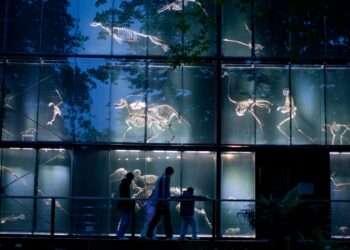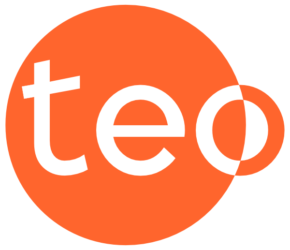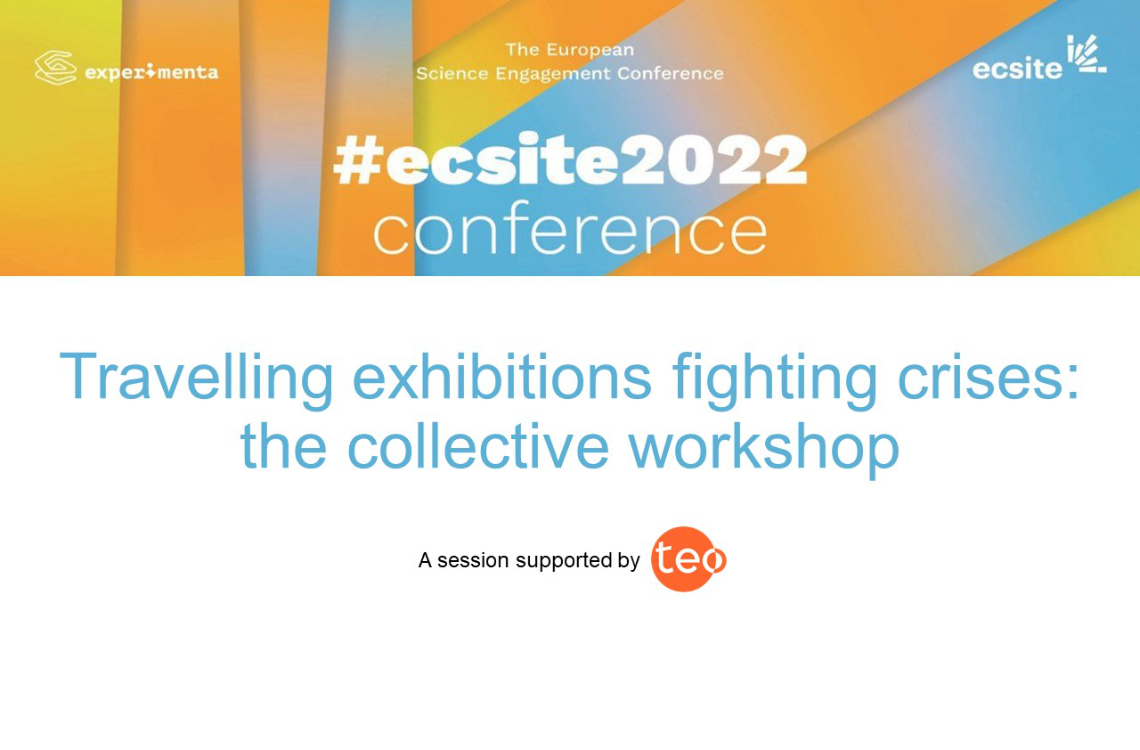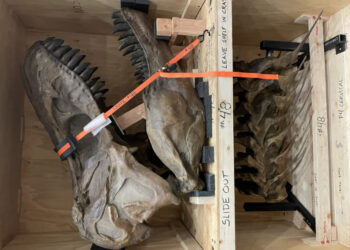After a two years pandemic and the rise of geopolitical crises such as the war in Ukraine, global business and more specifically for us, travelling exhibitions have been extremely challenged, up to a point where most actors were uncertain about the future of their touring activities.
With the idea of a “workshop” style session, professionals gathered during the 2022 conference organised by ECSITE, the European network of science centres and museums, in Heilbronn, Germany. The workshop team shares here the results of the workshop, with ideas gathered with participants to help the travelling exhibitions industry through these crises.
Exhibition (re)development
Without an exhibition concept, there is no travelling exhibition! Starting with the basics, the content, formats and topics have to be adapted for touring productions to survive.
Such consecutive crises inevitably have an impact on programming: we have seen longer rentals and postponed presentations, creating a gigantic Domino Day in our travelling exhibitions schedule that no one wants to experience again (never say again to an exhibition producer the words “addendum” and “dates” together, and of course, the most dreaded one: cancellations !). When the crisis was hitting hard at the beginning of Covid-19, there was quite a general consensus and many solutions were naturally found. Today, in some cases, it has become harder to manage and organise programming, as many stakeholders have become more risk averse.
Since clients and installers could not travel, many producers have started developing additional tools, such as virtual tours, and remote tours and installs, thanks to virtual meetings tools and install documents. Working with local staff was a good way to save on some logistics costs, but the amount of time spent on training and manuals has to be valued as well, as these indeed require a huge amount of work (see logistics paragraph). Virtual and remote tools are also useful for technical support, and can be good marketing tools, serving both the producer and host venues – notably by supporting exhibition discovery with virtual visits. Offering additional online curated content could also be a plus, by providing a platform to connect even more with the exhibition and with the host partner. Of course, there are these outstanding questions of the profit & loss of these additional contents: is it serving more the host venue or the producer? Who should pay for this? Could it be part of a customer care strategy for long-term loyalty?
Localising the content is also a good response to lower some production costs [...] and create a deeper emotional connection.

When programming is upside-down, maybe that is a good opportunity to take the time to repair, maintain and do these upgrades to exhibition content that requires adjustments after a few years. “Down times” are a good moment to take a deep breath and look at your activity and production methods. For example, the Natural History Museum in Toulouse took this “time-off” opportunity to create a 100% eco-built exhibition, by re-using and re-purposing an exhibition which was created years ago by the Natural History Museum in London. It was a first-time experience for them, but the sustainability challenge gave them the taste for creating future exhibitions like that again.
Beyond reusing exhibition material, some also looked at developing a standard or common scenography, with similar elements that could be plugged and unplugged, but still giving the opportunity for some variations. For example, Universum Bremen is using aluminium poles that can be combined in different shapes. Not only they last longer, but they also allow different combinations, with flexibility and modularity.
Crisis are always there to make us rethink our approach, and with the increase in cost of materials and shipping, it was critical to make the offered travelling exhibitions packages evolve. Blueprints or digital packages can be a good solution, but printing the package also generates disposable materials, and when it comes to comparing the carbon footprint of an exhibition locally re-created from blueprints or the impact of shipping, it would really depend on the size and technicity of the exhibition. From a panel photography exhibition to a high tech 600 sqm exhibition, it’s way different! Our ability to make objects from collections or even artifacts or casts travel, is also put into question. The alternative of localising the content is also a good response to lower some production costs and makes it even more relevant to the community hosting the exhibition, with the potential to create a deeper emotional connection.
Even with lowered budgets, the expectations are still there. Host venues and producers have shown incredible amounts of creativity to make this work, such as rethinking models too.
A new realm for partnerships models
The host venue and producer’s agendas are not always aligned. When an extension is not possible because programming is set, what else could be done? Even offering the exhibition at no costs may not make any sense, not only from a commercial partnership point of view, but even for hard costs since these have all been on the rise, and most of them can be unexpected. From our conversations, many museums and producers have been willing to share some costs, such as storage. However, this was the case at the height of the pandemic when everyone was solution-focussed and willing to compromise. This may not always be the case in the future.
When sharing the risks, benefits have to be shared too! Revenue share models have gained popularity once again, which was new to many museums or “non-profit” venues. It is a real sign of collaboration, fully based on trust. Hard costs remain there, but this is a balanced solution: it saves on storage costs and provides new marketing visibility for the producer. It can also bring some press coverage for the host and still drives revenue first, not only for the museum, but also to the local community and the overall venue’s ecosystem.
Even though contracts have been augmented and getting more specific, there is a shift from a buyer/seller relationship, to a more collaborative one. Financial schedules have been impacted too: many deposit amounts have been reduced, and longer payment schedules tend to become the norm. We are all part of the same ecosystem, and we need each other to survive and thrive.
Is that a more balanced relationship now? New partnership models have also impacted the contracts: new clauses have been added (or at least, everyone started paying more attention to the “Force Majeure” and “Cancellation” ones). It is not only about managing financial risks, but also about paying more attention to the needs and expectations of each party, making sure to have them listed thoroughly, even more nowadays – to have a clear understanding of each party’s responsibility, in the different scenarios. Above all, everyone agreed on the increased need for trust and good partnership – because even with the best contract in place, it is never in the interest of the parties to end up tied up in a court case.
The logistics: still a cornerstone?
Logistics have always been at the core of our travelling exhibitions models, even though they may not be the sexiest part of it: most of us have to deal with exhibitions that have not been really thought for travelling (hello, most museum friends!), and the need for bigger, richer and more immersive experiences has been endlessly increasing shipping volume (until now?). Unfortunately, we do not have a magic recipe for rescuing containers stuck in a port and readjusting an entire touring process. Uncertainty on costs and schedules is now an important aspect to take into account for all parties.
With increased shipping costs, improvement could already start with the reusing of crates of course, but also with their adaptation to better fit what they contain. It has been at the core of the American Museum of Natural History’s strategy for travelling exhibitions, with crates (see Crating for Travelling Exhibitions – 2021 Report) made to be more adjusted to what they protect, to reduce the shipping volume. Not only does this enables reduced costs for clients, but you can have more chances to find a slot in the next boat departing next week. This is important in a context where while we see some venues prefer to keep exhibitions longer, we also see increasing numbers of last minute hosting slots.
Beyond selling concepts and blueprints only, to reducing volumes, there are some alternatives that may still be explored, and not all of them will be a direct cost to producers. We were talking earlier about localising content… so why not also localise installers? By relying on a network of local companies the host partner may have already been working with, you can reduce costs and travel fatigue for your team. No one has been reinventing the wheel in our industry so far: so why not sharing your resources or providers’ contacts? By generating a local contractor eco-system, you also show that not only the travelling exhibition will serve the museum and its services (from restaurant to gift-shop), but it will also benefit the local hospitality world as well as local companies such as electricians or carpenters.
Open up! Film your teams while installing or de-installing an exhibition to complement your printed installation guide, make communications easy (are giant WhatsApp group dreaded or aren’t they fun in the end?), share more, be ready for trainings and guidance. So if you need a remote installation or would like to send less staff, you are ready. Not only it will empower the local team, but it will also be rewarding for your team to share their knowledge. Again, same with contracts, do not be shy on the expectations or skill set you need for local staff by being super specific. Your logistics staff will thank you!
By working with a local network, you will reduce travel expenses, time away from home for your staff, but also limit the carbon footprint impact and avoid local restrictions. This is also a good way to benefit from the knowledge of these local experts (are your team members up to date with electrical standards around the world?).
This is a long-term strategy: it’s not a one-off, we are committed here to create long-lasting relationships, for eventually renewed partnerships, or at least, certainly a great recommendation to other partners. Even more now, in such an uncertain context, trust and references are key.
Since venues will be sharing costs, why not be more transparent about the tour? You never know, another hosting opportunity may come up along the way because the new potential host knows you are in the area. We understood it has been hard planning ahead, but with better communication with potential partners and hosts, they will also be a good support to help build the tour. Who knows better than other museums what their peers are doing? From conferences to personal connections (and counting on TEO of course!) do not be shy to ask for a reference or an insight. By understanding the “radius” of your partners and their competition area, you will be more efficient in building the tour and in your outreach efforts. Is this so-called competition still a thing nowadays? By localising content, the question of being the 1st host in the area will be less relevant, as the exhibition will always be slightly different from venue to venue.
And what would a travelling exhibition be without the challenge of actually shipping it? Sharing knowledge could be helpful, as the Fine Art Shippers association does when it shares schedules to optimise tracking to fill up the space in trucks. Should travelling exhibitions producers create a similar strategy to optimise the way to fill-in their gaps in schedules?
Conclusion
We advocate for a greater transparency and a culture of collaboration to support our travelling exhibitions industry in times of crisis. We do not want to talk about competition anymore, because in the end, our exhibitions content, what they represent, what each of our home institutions represent, makes all of them so unique. Travelling exhibitions are not a common good. They are a “luxury” product (in the ‘tailor made” sense) within a niche market, with limited availabilities. If my exhibition about dinosaurs is not available on this specific timeframe, why not tell potential clients I know that this other dinosaurs exhibition is available? Wouldn’t it create a virtuous circle?
Just like sustainability has become a core area for improvement, we have to initiate the movement and not be afraid of a mindset shift.





